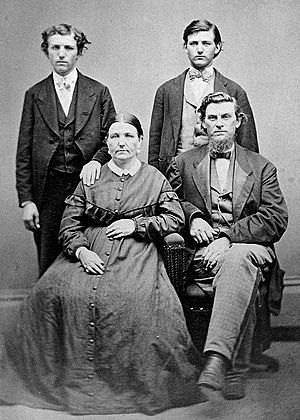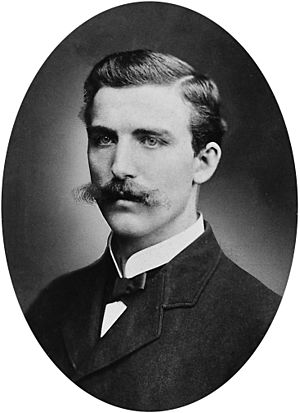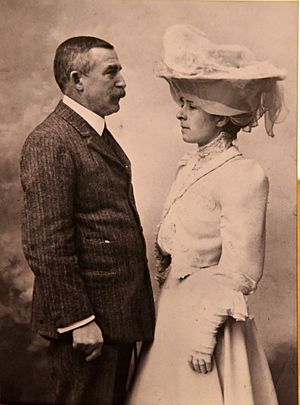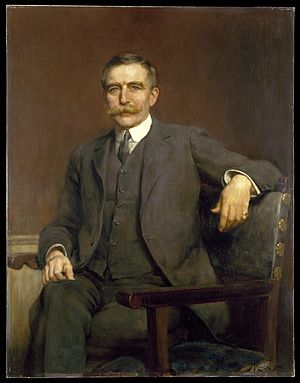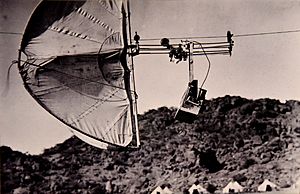Henry Wellcome facts for kids
Quick facts for kids
Sir Henry Solomon Wellcome
|
|
|---|---|
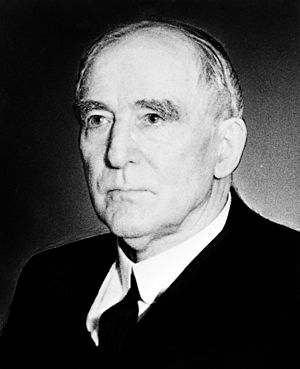
Henry Wellcome in 1930
|
|
| Born | August 21, 1853 Almond, Wisconsin, U.S.
|
| Died | July 25, 1936 (aged 82) Marylebone, London, England
|
| Known for | Founding Burroughs Wellcome & Company, GlaxoSmithKline and the Wellcome Trust |
| Medical career | |
| Profession | Pharmaceutical entrepreneur |
Sir Henry Solomon Wellcome (born August 21, 1853 – died July 25, 1936) was an American businessman who made medicines. He started a company called Burroughs Wellcome & Company with his friend Silas Burroughs in 1880. This company later became part of a much larger one called GlaxoSmithKline. When he died, he left a lot of money to start the Wellcome Trust. This is now one of the biggest charities in the world that helps with medical research. Henry Wellcome also loved collecting old medical items. Many of these are now looked after by the Science Museum, London. Some are even shown at the Wellcome Collection.
Contents
About Henry Wellcome
Early Life and Ideas
Henry Wellcome was born in a simple log cabin in Almond, Wisconsin, USA. His father was a traveling missionary. Henry became interested in medicine and how to sell products from a young age. When he was just 16, he sold "invisible ink," which was actually just lemon juice. He grew up in a very strict religious family.
Building a Medicine Business
In 1880, Henry Wellcome and his friend Silas Burroughs started their own medicine company. It was called Burroughs Wellcome & Company. They were the first to sell medicines in tablet form in England. They called these "Tabloid" medicines. Before this, most medicines were sold as powders or liquids.
They also had a new way of selling. They gave free samples directly to doctors. This helped doctors see how good their medicines were. In 1895, Silas Burroughs passed away. Henry Wellcome then took over the whole company. The business grew very well. Henry Wellcome even started several research labs. In 1924, he brought all his business and research work under one main company, called The Wellcome Foundation Ltd.
Personal Life and Later Years
In 1901, Henry Wellcome married Gwendoline Maud Syrie Barnardo. She was the daughter of Thomas John Barnardo, who started orphanages. They had one son, Henry Mounteney Wellcome, born in 1903. Their marriage was not very happy, and they separated in 1909. Henry Wellcome later became a British citizen in 1910.
He was honored for his work and was made a Knight Bachelor in 1932. This meant he could be called "Sir Henry." He also became an Honorary Fellow of the Royal College of Surgeons of England. Henry Wellcome died in London in 1936 at the age of 82. After he died, the Wellcome Trust was officially started.
Henry Wellcome's Lasting Impact
In his will, Henry Wellcome said that all the money from his company should be used to help human and animal health. This is how the Wellcome Trust began. It is now one of the world's largest private charities that supports medical research.
People have written books about Henry Wellcome's life. These books help us learn more about him and his amazing contributions to medicine and science.
The Wellcome Trust
After Henry Wellcome died, the money from his company was used to fund the Wellcome Trust. This trust helps pay for research and training for future scientists. It gives money to universities and labs to study diseases and find new treatments.
The Wellcome Trust is now the biggest charity in the UK. It supports many areas, including biomedical science, which is about understanding how living things work. It also helps new ideas become useful health products. The trust spends a lot of money each year to train people in medical research.
In the United States, a group called the Burroughs Wellcome Fund (BWF) was also started. In 1993, it became fully independent from the main company. It is now a private foundation that supports biomedical research in the U.S. The Wellcome Trust continues to start new programs. For example, it helps doctors who want to become researchers. It also supports research into new ways to treat problems like obesity.
Amazing Collections
Henry Wellcome loved collecting things related to medicine. He wanted to create a "Museum of Man." He bought all sorts of medical items, even Napoleon's toothbrush! When he died, his collection had 125,000 medical objects. He also collected over a million other items.
Henry Wellcome was also very interested in archaeology, which is the study of old human history. He spent many years digging at a place called Jebel Moya in Sudan. He even used kite aerial photography to take pictures of the archaeological site from above. This was a very new idea at the time!
Today, Henry Wellcome's medical collection is looked after by the Science Museum in London. Many of these objects are now on display in the museum's "Medicine: The Wellcome Galleries." The Wellcome Collection also shows some of his items in an exhibit called "Medicine Man." His huge collection of books, paintings, and photos can be seen at the Wellcome Library.
Works
- Alte cymrische Heilkunde : ein Abdruck des historischen Andenkens. Burroughs Wellcome, London Digital edition by the University and State Library Düsseldorf
- The Story of Metlakahtla. London; New York: Saxon, 1887.
Gallery


